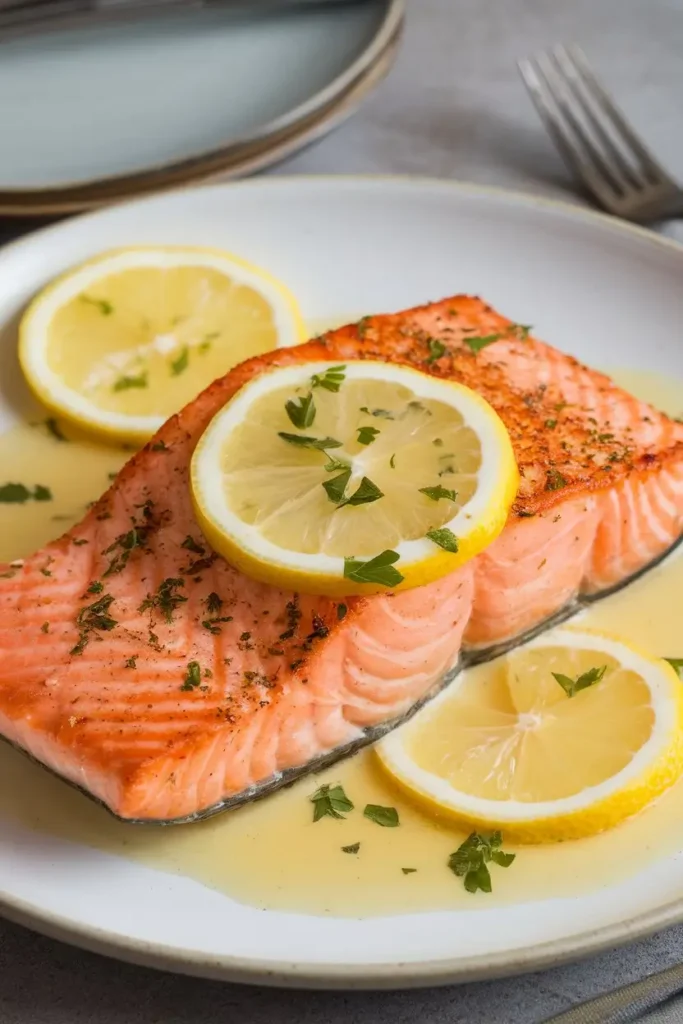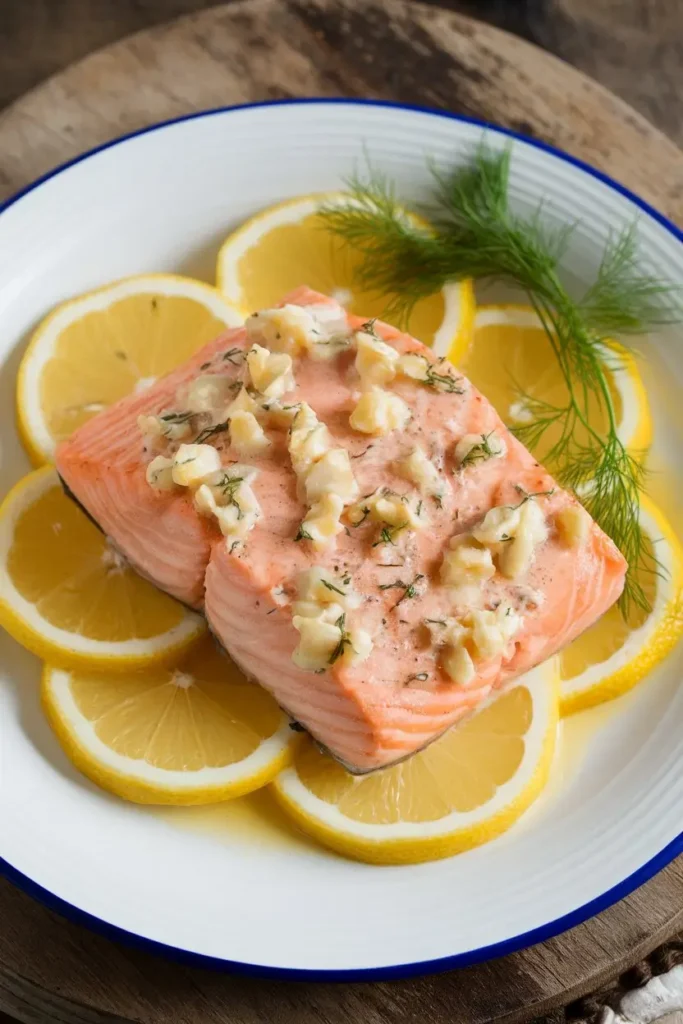If weeknight dinners feel rushed and repetitive, you’re in the right place. This simple garlic butter lemon salmon tastes like it came from a good bistro, yet it lands on the table fast, with minimal cleanup and maximum reward. The combination of garlic, fresh lemon, and warm butter turns flaky salmon into something special.
Garlic Butter Lemon Salmon That Tastes Restaurant-Quality at Home
Introduction
Can a pan of garlic butter lemon salmon really deliver crisp edges, juicy flakes, and a bright lemon finish in under 20 minutes? Home cooks often assume salmon needs a long marinade or complicated steps to add flavor. The data says otherwise: salmon fillets cook in about 4 to 6 minutes per half inch of thickness, which means a quick, hot method can preserve moisture and texture while keeping dinner on schedule.
That timeline pairs perfectly with a quick lemon garlic butter sauce. No extended marinade, no hard-to-find ingredients. Just focused heat, good seasoning, and a silky sauce that glosses the fish at the end.
A few more reasons to feel confident:
- Salmon is naturally rich in omega-3s, with many fillets delivering 1 to 1.7 grams per 100 grams, a meaningful boost for heart health.
- The FDA recommends 145°F for fish, yet many chefs target 125 to 130°F for a moist center. Choose your preferred finish with a thermometer and hit the texture you love.
Ingredients
Here is a clean, flavor-forward list that hits all the right notes. You will smell the garlic bloom, the butter turn glossy, and the citrus lift everything.
- Salmon fillets, 4 pieces, skin-on, 6 ounces each
- Kosher salt, 1 to 1.25 teaspoons
- Freshly ground black pepper, 0.75 teaspoon
- Garlic, 3 to 4 cloves, finely minced
- Unsalted butter, 4 tablespoons
- Olive oil, 1 tablespoon
- Lemon, 1 large, zested and juiced (about 2 tablespoons juice)
- Fresh parsley or dill, 2 tablespoons, chopped
- Lemon slices for garnish
Optional accents that add character without complicating things:
- A pinch of red pepper flakes for heat
- 1 teaspoon Dijon mustard for gentle tang
- 1 tablespoon dry white wine to loosen the sauce
- 1 teaspoon honey to round the acidity
Smart substitutions:
- Salmon type: Sockeye for leaner texture and deeper color, Atlantic for a richer feel. Trout or arctic char also work and cook on a similar timeline.
- Butter: Use ghee for a toasty note and less milk solids, or use half butter and half extra-virgin olive oil to reduce saturated fat while keeping flavor.
- Garlic: Granulated garlic works in a pinch, 1 teaspoon per clove.
- Herbs: Parsley, dill, chives, or thyme. Use what you have, keep it fresh.
Timing
- Prep time: 8 to 10 minutes
- Cook time: 8 to 10 minutes
- Total time: about 18 to 20 minutes
Most baked or poached salmon recipes clock 22 to 30 minutes. This method trims that by roughly 20 to 30 percent while increasing browning and keeping the center tender. The key is a hot pan or an efficient oven setting.

Step-by-Step Instructions
Step 1: Prep the salmon like a pro
- Pat the salmon very dry on both sides. Water on the surface creates steam and blocks browning.
- Season evenly with salt and black pepper. Let it rest at room temperature for 10 minutes while you set up the pan and the sauce ingredients. Bringing the fish a bit closer to room temp makes cooking more even.
Tip: If your fillets vary in thickness, aim thicker pieces toward the center of the pan and thinner ones near the edges.
Step 2: Mix a fast garlic lemon butter
- In a small bowl, combine the lemon zest, lemon juice, minced garlic, and chopped parsley.
- Melt 2 tablespoons of butter and whisk it in. Keep the other 2 tablespoons for finishing.
- If using Dijon, wine, or honey, add now. Taste for balance. You want bright acidity and a rounded finish.
Tip: Zest first, then juice. Zesting a halved lemon is awkward. A microplane extracts aromatic oils without the bitter pith.
Step 3: Choose your path: skillet or oven
You have two reliable routes for garlic butter lemon salmon. Both are weeknight-friendly and both concentrate flavor.
- Skillet method: Best for crisp skin and a little caramelization.
- Oven method: Best for ultra-even cooking with hands-off time, also great for thicker fillets.
Pick your favorite. Or pick based on what else is happening in your kitchen.
Step 4: Skillet method for crispy skin
- Heat a large stainless steel or cast-iron skillet over medium-high heat for 2 to 3 minutes. Add the olive oil.
- When the oil shimmers, place salmon in the pan skin side down. Press gently with a fish spatula for 10 seconds to keep the skin flat.
- Cook until the skin is crisp and the salmon is about 70 percent done, 4 to 6 minutes depending on thickness. The color will climb up the sides.
- Flip, reduce heat to medium-low, and pour in the lemon garlic butter mixture. Add the remaining 2 tablespoons butter in small pieces.
- Spoon the sauce over the fillets while they finish, 1 to 3 minutes. Aim for 125 to 130°F for a moist center, or 140 to 145°F for a firmer texture.
Tip: If the garlic starts to brown too fast, slide the pan off heat for 20 to 30 seconds, then return it. Keep the sauce blond and fragrant, not dark.
Step 5: Oven method for set-and-forget ease
- Heat the oven to 425°F. Line a sheet pan with parchment for easy cleanup.
- Lay the salmon skin side down. Brush lightly with olive oil and season.
- Bake for 7 to 10 minutes, depending on thickness.
- Pull the pan, pour the lemon garlic butter over the fish, and return to the oven for 1 to 2 minutes. For a little color, switch to broil for 45 to 75 seconds and watch closely.
Tip: The “10 minutes per inch” guideline is a useful starting point. Measure the thickest point and adjust.
Step 6: Finish with acid and herbs
- Taste the sauce in the pan. Add a squeeze of lemon if it needs more lift, or a small knob of butter for extra gloss.
- Sprinkle with fresh herbs. Add lemon slices for a bright look at the table.
Step 7: Rest briefly and serve
Let the salmon sit for 2 minutes to relax the proteins. This keeps the juices from rushing out when you plate.
Nutritional Information
Numbers below are estimates for one serving, based on 4 servings from 1.5 pounds of salmon, 4 tablespoons butter, and 1 tablespoon olive oil.
| Nutrient | Amount per serving | Notes |
|---|---|---|
| Calories | ~480 to 510 kcal | Varies with salmon type and butter amount |
| Protein | ~32 to 36 g | High-quality complete protein |
| Fat | ~36 to 40 g | Includes omega-3 fats from salmon |
| Saturated fat | ~13 to 15 g | Primarily from butter |
| Carbohydrates | ~1 to 2 g | Very low carb, keto friendly |
| Sodium | ~500 to 750 mg | Depends on salt and butter brand |
| Omega-3s | ~1.5 to 2.5 g | EPA + DHA estimates for typical salmon |
| Cholesterol | ~120 to 160 mg | Salmon plus butter |
| Potassium | ~800 to 1000 mg | Salmon is naturally rich in potassium |
Safe-cooking guidance: The FDA target for fish is 145°F. Many cooks prefer 125 to 130°F for a moist center. Choose based on your taste and audience.
Healthier Alternatives for the Recipe
- Lighter sauce: Use 2 tablespoons butter plus 2 tablespoons low-sodium chicken broth. You keep the silkiness with fewer calories.
- All olive oil: Swap the butter for 2 tablespoons extra-virgin olive oil. You get a fruitier finish and less saturated fat.
- Yogurt drizzle: Stir Greek yogurt, lemon juice, garlic powder, and dill. Spoon over the salmon after cooking for a tangy, creamy topping without extra butter.
- Dairy-free: Use olive oil or a quality plant-based butter.
- Lower sodium: Season with a 50-50 blend of salt and lemon zest, or finish with flaky salt at the table for more control.
- Different fish: Trout or arctic char cook similarly and pair well with this sauce. Halibut works too, but it is leaner and benefits from extra sauce.
- Air fryer option: 400°F for 7 to 9 minutes for 6-ounce fillets. Add the lemon garlic butter in the last minute or spoon it on immediately after cooking.
Dietary notes:
- Gluten free: The base recipe contains no gluten.
- Low carb and keto friendly: Carbs stay near zero.
- Pescatarian friendly: Yes.
Serving Suggestions
Go bright and green or lean into cozy and buttery. Both styles work.
- Citrus-herb rice with extra lemon zest and chopped parsley
- Roasted asparagus, broccolini, or green beans
- Simple arugula salad with shaved Parmesan and a lemon vinaigrette
- Garlicky mashed cauliflower for a low carb side
- Quinoa with toasted almonds and dill
- Herbed couscous with olive oil and chopped chives
Extra touches:
- Add capers to the sauce for briny pops.
- Serve with lemon wedges so everyone can adjust acidity.
- Wine pairing: Sauvignon Blanc for citrusy lift, or a lightly oaked Chardonnay if you want a creamier match.
Common Mistakes to Avoid
- Starting with wet fish: Pat very dry for proper browning and to prevent sticking.
- Crowding the pan: Overcrowding lowers heat and steams the fish. Use a large skillet or a sheet pan with space between fillets.
- Overcooking: A few minutes too long turns flaky into chalky. Use a thermometer and pull at your target temperature.
- Burning the garlic: Garlic cooks fast. Keep heat moderate once the sauce hits the pan, and swirl or baste continuously.
- Cold fillets: Very cold fish cooks unevenly. A short rest on the counter gives better results.
- Skipping zest: Zest holds the most intense lemon aroma. Juice alone misses that top note.
- Not salting early enough: A light seasoning 10 minutes ahead helps the salt penetrate and seasons more evenly.
Storing Tips for the Recipe
- Refrigerate: Store cooked salmon in a shallow airtight container for up to 3 days. Keep the sauce separate if possible.
- Reheat gently: Low oven at 275°F for 8 to 10 minutes, or a covered skillet over low heat with a spoonful of water to create steam. Microwaves work in short bursts at 50 percent power.
- Freezing: Wrap portions tightly and freeze for up to 2 months. Thaw overnight in the fridge. Reheat gently to protect texture.
- Make-ahead components: Mince garlic, zest the lemon, and chop herbs up to a day ahead. Mix the lemon garlic butter base without melting, then warm it when the fish is almost done.
Quick Recap and Next Steps
Garlic butter lemon salmon, ready in about 20 minutes, with crisp edges, juicy flakes, and a bright citrus finish. Try it tonight, then share a rating and a comment with your tweaks. Want more easy dinners and flavor-packed sauces? Subscribe for updates and fresh recipe ideas.
FAQs
How do I keep salmon from sticking to the pan?
- Dry the fish well, heat the pan before adding oil, and avoid moving the fillets for the first minute. A stainless or cast-iron skillet with enough preheat helps build a nonstick surface via the Maillard layer.
Is skin-on or skinless better?
- Skin-on protects the flesh and crisps up beautifully. If you prefer skinless, reduce heat a touch and be extra gentle when flipping.
What internal temperature should I aim for?
- FDA guidance is 145°F. Many cooks prefer 125 to 130°F for a moist center. Pull slightly early, then rest 2 minutes as carryover heat finishes the job.
Can I bake everything with the sauce from the start?
- You can, but adding the lemon garlic butter near the end keeps the garlic from over-browning and preserves bright lemon flavor.
What size fillets work best?
- Aim for 6-ounce portions, about 1 to 1.25 inches thick at the center. Thinner pieces cook fast and can dry if left unattended.
How do I scale the recipe for a crowd?
- Use two sheet pans and rotate halfway through baking. Double the lemon garlic butter and keep a little extra warm for serving.
Could I use frozen salmon?
- Yes. Thaw overnight in the fridge, then pat dry before seasoning. If cooking from frozen in an air fryer, add a couple of minutes and sauce at the end.
What herbs pair best besides parsley and dill?
- Chives, tarragon, and thyme fit well. Basil adds a sweet, peppery twist during summer.
Can I make it spicy?
- Add red pepper flakes to the butter or finish with a drizzle of chili crisp for a lively kick.
Any tips for meal prep?
- Cook slightly under your usual doneness and reheat gently. Pack with lemon wedges and a simple grain or salad so the plate tastes fresh even on day two.
Looking for more ideas? Try this sauce on trout or arctic char, use it as a spoon-over for steamed asparagus, or tuck leftovers into a bright salmon salad with herbs and lemon.


